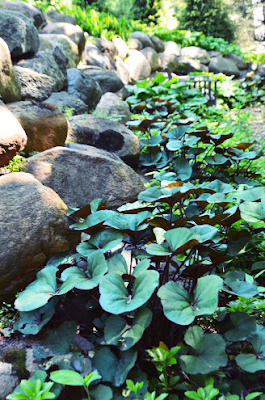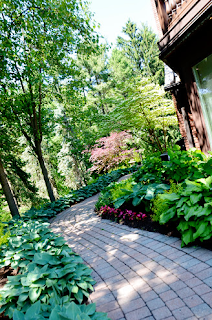
Years of trial and error in the shadow of giant oaks and towering spruces have bestowed some insight into the hardiest choices for those dappled gardens where sunlight's at a premium.

When we moved to our new home, Bill and I became the custodians of a shady island at the end of our driveway. Moving from a riverside valley to the top of a sunny hill, the little island became the landing pad for most of the transplants who'd made the trip.
Now the median looks like a test site for Shady Acres.

On Independence Day we decided to free three frazzled blue hostas from a sunny patch atop the hill.
Thirty minutes later the trio had a shady home, anchoring the curved edge of our island garden.
 |
| Hosta |
Beneath a canopy of leaves and whorls, here's what's shines in the Midwest shade parade:
Shade Borders:
1.
Hosta: Hosta's easy and low maintenance. With countless varieties the choices are limitless. The plantain lily adds density and texture to any garden. Leaves bow gracefully, adapting to the location. Spiked
blooms vary in color from stark white to lavender. Noninvasive, hostas are best transplanted in the fall allowing the leaves to flow naturally into the new space by spring. I've scooped out hosta root, tossed the base into a new hole, and covered the hosta with leaves while snowflakes swirled overhead. Not recommended, but these late transplants survived and thrived, with minimal time to reestablish.
 |
| White Cranesbill Geranium |
2. Geranium cranesbill: Cranesbill sport lacy leaves and delicate flowers in shades of pink, white and lavender. Like hosta, they're mounding plants, best suited for the front of the garden. Sweet scented leaves assist in deterring mosquitos.
3. Heuchera: Coral Bells add burgundy color and fare better in deep shade over newer lime and copper toned varieties. Generally, the darker the color, the better the survival rate, and the less sun required.
 |
| Astilbe |
Mid-garden:
1. Astilbe: Astilbe reaches two to three feet in height with pointed leaves that offer more movement than other shade plants. Plume-like flowers in late spring come in pale shades of salmon, ivory, hot pink and dramatic red. Astilbe needs no cutting back. They arrive early in the spring and begin die back in late summer. Astilbe establishes well with regular watering, but once committed resists transplantation.
 |
| Monkshood |
2.
Monkshood: The slender curved leaves resemble those of daylilies. I transplanted some last spring, thinking they were Stella d'Oro. Then soft purple blooms came as a pleasant surprise in late
 |
| Turtlehead |
spring, lasting
through July.
3.
Turtlehead: With hot pink or white blooms on medium sized stalks, this fall bloomer is a favorite. Also called the "lipstick plant" vegetation spreads slowly with little reseeding.
 |
| Liguria / Rayflower |
4. Liguria: Known as the Rayflower, sunny yellow blossoms emerge from the center of this rounding plant, offering drama in the shade. Plant tones come in burgundy or green with opposing colors on the downward side of the leaf. In a slight breeze all eyes are drawn to this underused plant. Reseeds easily.
 |
| Bleeding Heart |
5. Obedient plant: Thin stemmed with gathered pink or white blooms in early fall. This plant derives its name from the propensity to stay put when a stalk is put into place.
6.
Bleeding heart: One of the first spring bloomers, bleeding heart grow up to three feet across but die back to the ground each fall. After the distended flowers bloom in mid-spring, the bushy plant can be shaped. In the fall, leaves turn to bright gold. Reseeds, but noninvasive.
 |
| Fern |
7. Fern: Feathery fern look fabulous by the second year of planting, but by the fourth year, fern's prolific ability to multiply means the rest of the shade bed is about to succumb, making it a high maintenance choice for a mixed bed. Fern fares best in a mass planting area or hillside. An exception is the dainty painted fern which spreads at glacial speed and offers unusual color and textural components.
 |
| Petasite |
8.
Petasite: A prehistoric looking perennial, dinofood's rarely found in nurseries. The big-eared show stopper can be a bit pushy, but is easily contained. Early in the spring, small chartreuse blooms appear atop the soil like psychedelic turtles. By late spring, large
round leaves atop sturdy stems are the focal point of the garden. You'll find these lovelies at reclaimed plant sales and garden shops specializing in native woodland plants.

A shady garden is capable of as much vibrancy and variety as its sunny counterpart, Still, no amount of fertilizer will cause a "full sun" plant to bloom in the shade, The absence of sun means less stress on the plant.
Unschooled consumers may buy based upon apparent blooms rather than foliage.
It just takes a bit more effort to locate many of these dark lords as retailers tend to focus on higher volume sun lovers and a handful of old standards.
Still, there's nothing like a cooling breeze in the dappled shade on a blistering day.

Remember, as trees grow taller the sun gets smaller--and shade progresses.
As the Girl Scouts say "be prepared!"
More For Shade Lovers:
Hosta La Vista!
Turtlehead and Other Fall Blooming Plants
Springtime Loves a Bleeding Heart






































.JPG)













